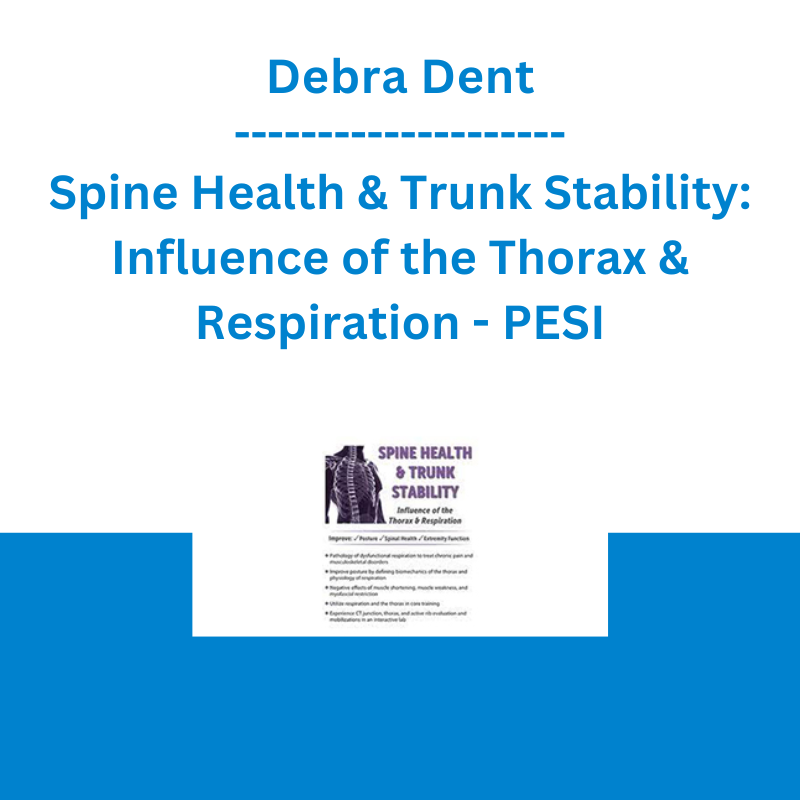*** Proof of Product ***
Exploring the Essential Features of “Debra Dent – Spine Health & Trunk Stability: Influence of the Thorax & Respiration – PESI”
Speaker: Debra Dent, BPT, Dip Manip PT, OCS, FCAMPT
Format: Audio and Video
Media Type: Digital Seminar
Description
An Evidence-Based Practice Solution for Spinal Health, Stabilization, & Posture
The thorax is a vital component of spinal function, as the center of trunk rotation. Its function is significant in shifting weight from lower extremities (LE) and upper extremities (UE) through regions of the spine. It is a prime base for muscle and fascial connections that affect the cervical/ UE and lumbo/pelvic/LE regions. The diaphragm’s dual functions are in posture and respiration. Its muscular and neurological connections to the lumbar spine, abdominals, and pelvic floor, along with its ability to maintain intra-abdominal pressure, are both vital for spinal stability and functional posture.
Dysfunction of the respiratory complex, trunk muscular imbalances, muscular inhibition and weakness, myofascial restrictions, loss of axial rotation, and chronic hyperventilation all have significant effects on posture, trunk stability, chronic pain, motion, and upper and lower extremity function.
This recording improves your knowledge and skill set regarding spinal health, stabilization, and posture. Ms. Dent demonstrates the vital integration of the thorax and diaphragm into a functional spinal program for long-term, successful patient outcomes. Participants will discover how normal breathing patterns are regained and maintained for spine health and overall patient well-being. Practice these techniques in an interactive, hands-on lab and leave with the confidence to immediately implement them into practice.
Speaker
Debra Dent, BPT, Dip Manip PT, OCS, FCAMPT, has nearly 40 years of experience specializing in manual therapy of the spine. She is a graduate of the University of Manitoba, Canada where she received her Diploma of Physiotherapy and her Bachelor of Physical Therapy. Ms. Dent also received her Advanced Diploma of Manual and Manipulative Physiotherapy and is a Fellow of the Canadian Academy of Manual Therapists (FCAMPT). She is certified as a Part B Manual Physical Therapist from the Canadian Physiotherapy Association and is an Orthopedic Certified Specialist (OCS).
Ms. Dent was an instructor for the Canadian Physiotherapy Association prior to moving to the U.S. She has been a guest clinical instructor at the University of South Florida, teaching the Spinal Manual Therapy Program for the MScPT undergraduate program and has taught a large number of manual therapy courses in the U.S. and Canada.
Ms. Dent is the owner of Cross Border Seminars and presently works as a consultant and contract PT in Palm Harbor, Florida. Her primary case load is rheumatology/fibromyalgia patients and she works with a multitude of related dysfunctions, as well as aging and osteoporosis.
Speaker Disclosures:
Financial: Debra Dent is the owner of Cross Border Seminars. She receives a speaking honorarium from PESI, Inc.
Non-financial: Debra Dent has no relevant non-financial relationship to disclose.
Objectives
- Analyze clinical implications for various patient populations.
- Characterize the function of the diaphragm as it relates to posture, muscular relations, and stability of the spine.
- Evaluate musculoskeletal issues in respiratory dysfunction.
- Categorize sympathetic vs. parasympathetic responses in neuromuscular control.
- Articulate pathologies related to less than optimal respiratory function.
- Choose effective techniques to alter respiratory patterns and trunk core stability.
- Individualize education for patients with breathing pattern disorders.
Outline
Clinical Observations & Implications
- Evidence-based practice and clinical observation
- Clinical implications for patient populations
Chronic low back and SI joint pain
Scoliosis and trunk weakness in the elderly
Chronic hip and lateral knee pain
Chronic cervical pain and headaches
Shoulder impingement
Thoracic outlet syndrome
Fibromyalgia
Balance and gait deviations
Athletic performance - Case histories — Could this be your patient?
Chronic pain
Marathon runner/triathlete
Chronic low back and neck pain
Anatomy
- Respiratory and thoracic anatomy/biomechanics
Thoracic anatomy
Rib anatomy
Thoracic biomechanics
CT junction biomechanics
TL junction biomechanicsTrunk musculature
-Core-inner group
–Outer group
–Posterior oblique
–Deep longitudinal
–Anterior
–Lateral
–Psoas/hamstring integration
–Scalenes, SCM, C spine muscles
– Muscles of inspiration
– Muscles of expiration - Mechanics of respiration
Normal breathing-mechanical effects - Physiology of respiration
Lung volumes
Lung perfusion
Hyperventilation/alkalosis - Fascial integration
Thorocolumbar fascia
Lateral femoral fascia/IT band
Abdominal fascia
Cervical/UE and Pelvis/LE biomechanical relationships
Neuromuscular Control
- Central nervous system on muscle tone and movement
- Sympathetic and parasympathetic responses
Lab Demonstration
- Evaluation and treatment techniques
- Evaluation of posture as it relates to respiratory function, UE, pelvis and lumbar function
- Mechanics of respiration
- Diaphragmatic, lateral costal, sternal, apical breathing
- Diaphragm position
- Seated arm raise
- Seated trunk rotation
- Standing torque
- Muscle function testing
Supine active SLR
Prone active SLR and active arm raise
– TA, multifidus, and pelvic floor function
– Posterior oblique system
– Anterior oblique system
– Lateral system - Rib position and mobility testing and active mobilizations
- Length testing and lengthening techniques
- Core facilitation entry training program
- Case histories evaluations, treatments, and outcomes
Theory & Evidence-Based Practice
- Suboptimal breathing patterns
Over-inflation
Upper chest breathing - Diaphragm and thoracic restrictions effects on the lumbar spine/hips/LE, C spine and UE- trunk rotation, or lack of trunk rotation effects
Posture and flawed load transference
Trunk stability and the diaphragm/core/incontinence
Hypertonicity/over activation of the superficial trunk muscle
Chronic low back and SI joint pain with poor control
Scoliosis and trunk weakness in the elderly
Chronic hip and lateral knee pain
Chronic cervical pain and headaches
Shoulder impingement issues
Thoracic outlet syndrome
Fibromyalgia
Balance and gait deviations
Athletic performance - Respiratory alkalosis/hyperventilation and the consequences
- Chronic fatigue, fibromyalgia, chronic pain
Target Audience
- Physical Therapists
- Physical Therapist Assistants
- Occupational Therapists
- Occupational Therapy Assistants
- Athletic Trainers
- Licensed Massage Therapists
Please see the full list of alternative group-buy courses available here: https://lunacourse.com/shop/










 SMB - Options Training
SMB - Options Training  Greg Loehr - Advanced Option Trading With Broken Wing Butterflies
Greg Loehr - Advanced Option Trading With Broken Wing Butterflies  Cyndi Zarbano - 2-Day Advanced Lab Interpretation: Making Sense of Critical Patient Clues - PESI
Cyndi Zarbano - 2-Day Advanced Lab Interpretation: Making Sense of Critical Patient Clues - PESI